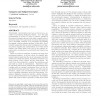Free Online Productivity Tools
i2Speak
i2Symbol
i2OCR
iTex2Img
iWeb2Print
iWeb2Shot
i2Type
iPdf2Split
iPdf2Merge
i2Bopomofo
i2Arabic
i2Style
i2Image
i2PDF
iLatex2Rtf
Sci2ools
GECCO
2005
Springer
2005
Springer
Behaviorally coupled emergent representation
Traditionally, representation has been perceived as a necessity for producing intelligent behavior. Once the right representation is in place to drive it, behavior unfolds as the system’s dynamics interact with what is usually a fixed, structural entity. For many kinds of systems this approach can be successful. However, as a prescription for building increasingly complex adaptive systems, it often fails. An alternative perspective that is under investigation in our Starcat project suggests that representation is not what drives behavior but rather what is left over by the system’s dynamics after concepts have been activated and behavior has emerged. There are numerous examples of patterns emerging from underlying dynamics. In an ant colony, for example, stigmergic behavior arises from the colony’s dynamics; but when viewed from outside the system, the pattern reveals the coupling between colony behavior and the environment. We could, from that perspective, consider the pheromo...
| Added | 27 Jun 2010 |
| Updated | 27 Jun 2010 |
| Type | Conference |
| Year | 2005 |
| Where | GECCO |
| Authors | Joseph Lewis, Jamie Lawson |
Comments (0)

